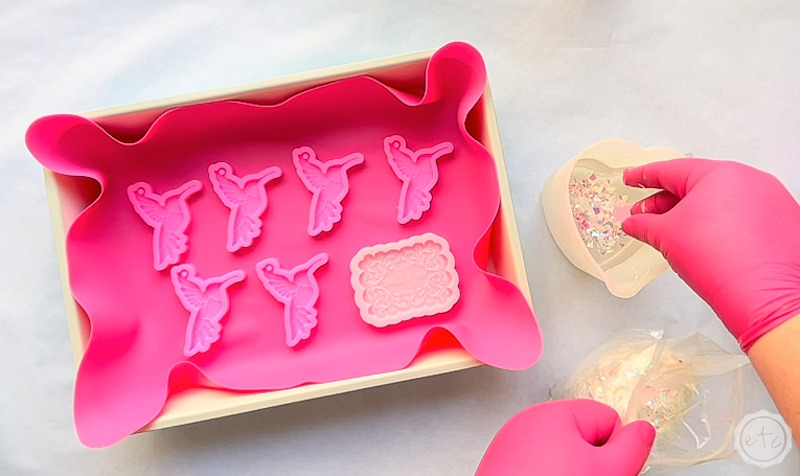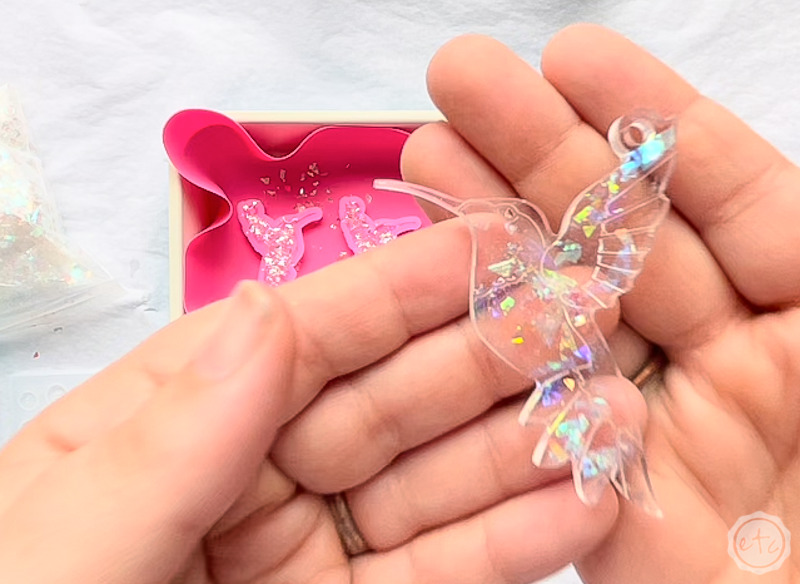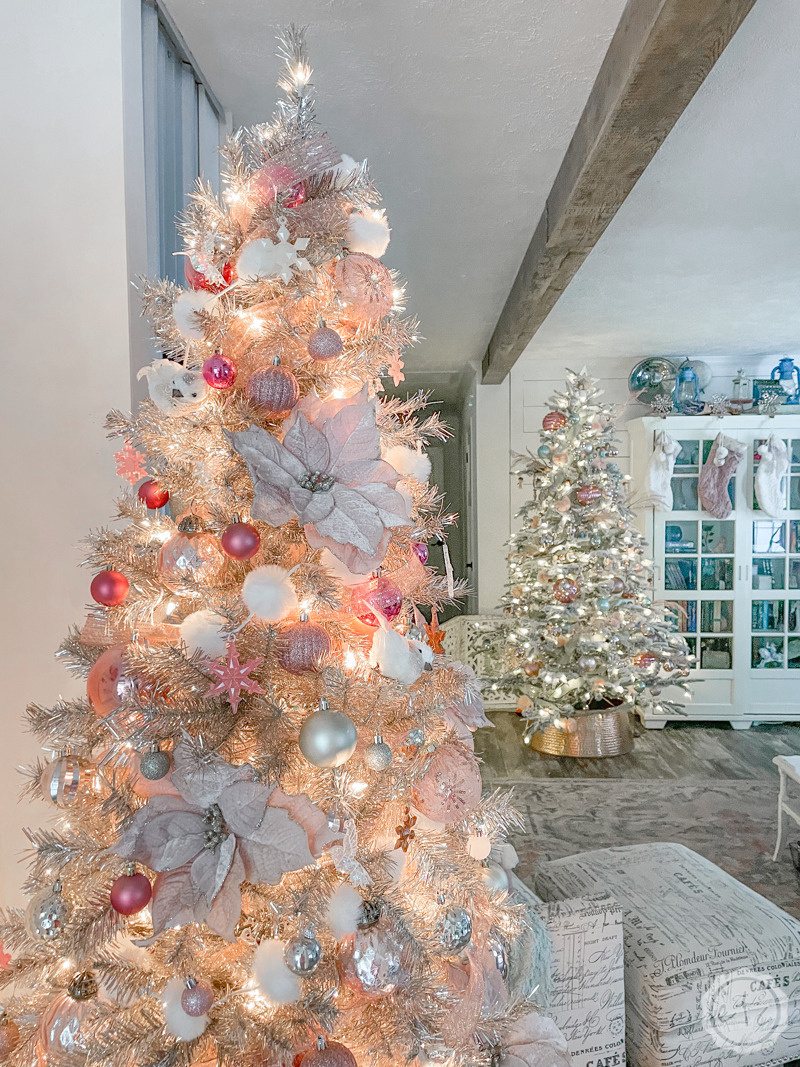

Last year I made a bunch of resin snowflake ornaments and honestly… they look amazing on my Rose Gold Christmas Tree. Which is great since finding ornaments that show up on a rose gold tree can be a little challenging… to say the least.
So when I found these little iridescent hummingbird ornaments I knew that I needed more of them. Or at the very least a few coordinating iridescent hummingbird ornaments! Especially since I have the iridescent flakes from my little resin crown trinket box project! The flakes come in a pretty big bag so I used them for a few “You’re on the Nice List” cards for my fun DIY Letters to Santa Mailbox as well. They’re just to cute not to use!
So I searched for a silicone hummingbird mold and when it came I got to work… adorable iridescent hummingbird ornaments coming right up!
Let’s get started!
Supplies:
- Total Boat Maker’s Epoxy Resin
- Hummingbird Silicone Mold
- Respirator/Mask (resin graded filters)
- Gloves
- Wagner HT400 Heat Gun
- Freezer Paper
- Silicone Mat
- Baking Pan
- Heart Shaped Silicone Mixing Cup
- Small Mixing Cups
- Silicone Measuring Cup/Larger Mixing Cups
- Reusable Silicone Stir Sticks
- Toothpicks
- White Craft Paint
- Iridescent Flakes
- Paint Brush
- Paper Towels
Just getting started with resin? Download my free resin supply list and make your first project today!

Step 1: Prep your Station
Ready to mix a little resin? Before we jump right into the project let’s prep our work station… gather all our supplies, cover all the surfaces with freezer paper, place all of our molds on silicone (in baking trays) so they can be easily transported into a safe space to cure overnight.
Another benefit of working in baking trays? These little molds came in a 6 pack which means we have 6 hummingbirds to make… and ideally they all need to level and room temperature to cure. The baking tray will let us carry the entire project inside to cure and will give us one larger surface to level instead of 6 tiny ones.
Genius.
Just remember you need a really well ventilated space to work with resin and since I have 5 dogs and a cat inside (without a workspace and air ventilation system) that place (for me) is my front porch. That means a little extra prep work (and moving resin as it cures work) but it’s totally worth it to be able to turn out resin projects like these. Don’t let a lack of work space keep you from creating!
Once you have your space set up make sure you have all of your supplies: including those iridescent flakes. You don’t want to be mid pour and have to go riffling through your glitter collection… make sure you have all your supplies before you start to mix your resin!
Then it’s time to grab your resin and get started. Resin needs to be room temperature (not too hot or too cold) so I like to leave it inside while I’m setting up so that it doesn’t change temperatures while I’m prepping my space. Resin that’s too hot will cure too quickly and resin that’s too cold will have lots of bubbles.
You’ll also want to keep temperature in mind when picking a day to work on your resin creations… a super cold or rainy day won’t let your pieces cure as quickly while a scorching hot day will cook the pieces faster. You want nice weather for a resin work day!
Now that we have everything in one space let’s jump in (before it gets too cold… it is December at the moment!)




Step 2: Mix your Resin
The best part of this project is that I have 6 molds! Usually I have to make one piece, wait for it to cure, de-mold it and then pour another one… which is fine but a pain in the rear. This time we can make 6 hummingbirds at once!
Which is perfect since I want quite a few for my tree.
Let’s start by pouring your resin in equal parts (a and b) into your mixing cup. I like to pour my projects in large groups to minimize the amount of times I have to turn my front porch into a resin workshop but this particular set of molds used about 50ml of resin… so that’s 25ml of part a and 25ml of part b.
That’s a little under 10ml each if you’re trying to make an individual hummingbird.
Don’t forget that as soon as you open that resin bottle you need to have on all of your personal protection equipment: gloves, respirator and even eye protection if you have it.
Now make sure to stir slowly for 3-5 minutes until the resin is thoroughly mixed. Scrape the sides and the bottom of the cup often to make sure alllll of the resin is incorporated into the mixture but try not to lift your stir stick out of the resin. You want to minimize the amount of bubbles in the mixture and the easiest way to make bubbles is to a) mix really quickly or b) lift your stir stick out of the cup over and over.

Bonus Tip: If you’ve never mixed resin before it’s not nearly as intimidating as you’d think! I’ll walk you through all the steps here in my How to Mix Resin for Beginners Tutorial.


After you’ve mixed your resin for 3-5 minutes and it feels really mixed up we can add our iridescent flakes. These little babies are gorgeous in resin but the best part is they’re nothing like glitter. Glitter is kind of a pain in the rear as it’s heavy and alllll falls to the bottom (or the front) of your mold. Which isn’t great if you’re trying to make 3-dimensional objects.
On the other hand these iridescent flakes stay suspended in the resin and don’t settle to the bottom! Which is kind of amazing! You can basically add them to your resin, stir and go. You don’t have to wait for your resin to thicken up. Which is great since resin pours the best right after it’s been mixed.
I’m getting away from the topic… go ahead and add a pinch or two to your resin and stir it until the flakes are evenly distributed. If you need more go ahead and add more just keep in mind that while you can always add more but you can’t take them out!
One more tip? If you already have resin on your gloves take them off and get new ones before grabbing your bag of iridescent flakes… you don’t want to permanently stickify your crafting supplies.
And yes… stickify is a word.



Step 3: Pour Resin into your Silicone Mold
All set? Ready to roll? Perfect! Let’s go ahead and pour our resin before it starts to cure.
Double check real quick though: is your mold clean of all dust and dirt? If the answer is yes then you’re good to go. I always always always try to pour from high up in a thin stream. The thinner the stream of bubbles the less bubbles make it into the mold… and minimizing bubbles is always the name of the game but it’s especially important when your mold has a teeny tiny little beak and a circular section where bubbles can settle and get stuck.
Just keep pouring in as thin a stream as possible until all of your molds are full. I know that pouring in a thin stream can be hard with the flakes (especially in these little tiny areas) but just try your best. I find it works best if you pour the resin in as central a location as possible (the body and tail) and then let it settle into the smaller areas.
Once the resin has settled you can use the tip of a twist tie or toothpick to guide the resin down into those narrow areas. Pay special attention to the circular opening and the tiny beak… and while you’re guiding the resin through these areas use your toothpick to push any little bubbles that have gotten stuck to the surface.
Then you can pop them with your heat gun!
Most of the iridescent flakes will stay suspended just fine on their own but while you’re working the resin you can always push the flakes around a bit. Make sure that you have even coverage and there aren’t a lot of empty spaces.
Once you’re happy with the look of your hummingbird and all the bubbles are popped go ahead and carefully take your entire baking tray to a cool (temperature controlled) location to cure overnight. Honestly? I like to set mine in my guest bathroom so that they’re inside, no one messes with them and I don’t have to smell the cooling resin. It definitely still smells like resin as it hardens (and no one wants to wear a respirator for 24 hours) so you’ll want it to be somewhere out of the way (with a door).
Another tip? Cover the tray so that no dust or dirt (or dog hair) can settle in the resin as it cools. Then leave the entire piece for about 24 hours. Once the resin has cured we’ll move on to de-molding!


One last tip before I go… once I was finished with my little resin pour I decided I needed a few more iridescent flakes. So as an experiment I added an entire layer of pretty Mylar confetti to the back of 3 hummingbirds.
I left the other 3 alone so that I could compare them once I was finished with this little project and see which version I liked best. Spoiler alert: the ones with fewer flakes looked amazing in open air but when hung on the tree? The ones with the full iridescent flake backing were spectacular. The light coming through all those little flakes is the best.



Step 4: De-mold your Resin Piece!
Once it’s been about 24 hours we can go ahead and free all of these little hummingbirds from their silicone prison. Start from the outside and carefully pull the edges of the silicone away from your piece. The silicone will stretch realllllly far if you need it to but you don’t want to stretch it to far out of shape… once you have the edges all pulled back (so that you can actually grab the resin piece) you’ll want to pull the resin piece free from the mold.
Volia! De-molding finished!
This is always the best part of the project… you get a first look at how fabulous your pieces are going to look when they’re finished!
Now all you need to do is make sure your silicone mold is clean and you can put it away for the next project (or make another round of hummingbirds… we need so many more!). If possible try to store all of your silicone molds flat in a temperature controlled place so that they don’t distort and warp over time. Perfect!
One little thing to mention about the 3 hummingbirds that i added extra flakes to? By adding flakes to the back instead of mixing them into the mixture we’re forfeiting our clean lines straight out of the mold. Instead we’ll have to cut/slice off the excess resin and flakes on the pieces where we added extra flakes. This was pretty easy though… I just used a pair of scissors and in some of the smaller areas an exacto knife.



Step 5: Paint the Indention’s
At this point you could be finished… but do you see the difference in the resin pieces above? How when the sun hits them the surface is shiny and the indention’s are clearly visible? That’s great but we can’t rely on the sun alllll the time. Especially since I want to be able to see those indention’s on the Christmas tree and without a little definition they’ll fade right into the branches.
So instead of relying putting our Christmas tree on the front porch and relying on the sun we’re going to use a little paint to highlight those indention’s.
Luckily this is a pretty easy process.
Basically we’re going to add a bit of craft paint to our piece and then use our paper towel to wipe the paint off. This will leave the paint in the indention’s while the surface is super shiny smooth.
Perfect!
A few tips? The paint wipes off super easy while it’s wet so work in small sections… paint, wipe, paint, wipe. Another tip is that if you’re having trouble removing paint from small areas a q-tip comes in handy!
Ready for the last tip? When you’re painting try not to put paint alllll over the sides of your piece. It will wipe off but I find it way harder to remove paint from the sides v.s. the front (go figure) and honestly it’s much easier to just avoid painting the sides in the first place.




Don’t forget to cut off any of the extra flakes or resin that spilled over the edges when we added the extra flakes.
It’s a simple step but it really helps to keep the shape of the hummingbird!
Just look how pretty they turned out! Can you tell which one has the flake background and which one doesn’t? Hint: the one on the left has the flake background!
Ok, that wasn’t a hint but you get the idea. Let’s go ahead and hang these bad boys on the tree!


At this point our little resin pieces are finished! I can’t wait to show you how they look on the rose gold tree! I’m going to add a few ornament hooks and hang them on my rose gold Christmas tree with my little resin snowflakes!
One last thing before I go… putting resin ornaments on a tree is always a risk. I use long ornament hooks and pliers to twist the hook around the ornament a few times… and then to twist the hook around the branch a few times.
Basically resin is poisonous. That’s why we need gloves and a respirator to work with it. Of course, once it’s cured it’s perfectly safe to smell but it’s always always always poisonous to eat. Which is why I don’t want to take any chances that these little guys could fall (or be pulled) off the tree and chewed on by my puppies, swatted at by my cat, mouthed by teething babies (not that I have any of those but my friends do).
Heck sometimes husbands put things in their mouths too.
It’s not worth the risk… secure the resin on the tree so it can’t come off without a lot of effort or just skip this project all together.
Look at the pictures… that’s close enough!
Okay, I’m getting down off my soapbox. I hope you enjoy the finished photos of this little project. It turned out so cute!





Here’s the original ornament I found… just for comparison.






Looking for even more pretty blush and rose gold projects? Here’s a few of my favorite projects from this year’s Blush and Seafoam Christmas or all the projects I made for last year’s Blush & Rose Gold Christmas!


Looking for more resin projects? I’ve got you covered!




















Leave a Reply